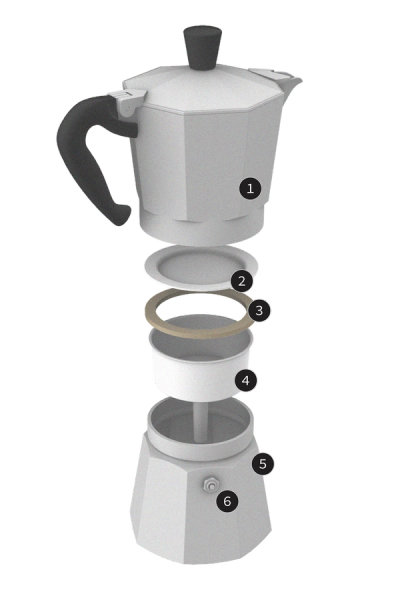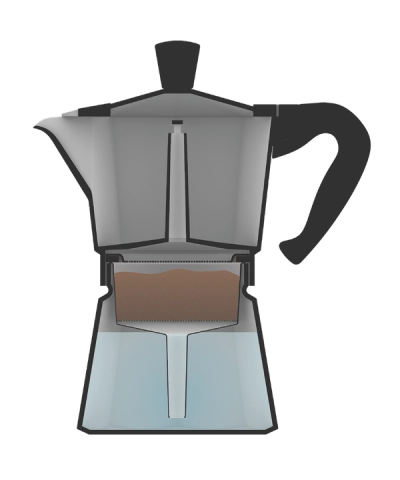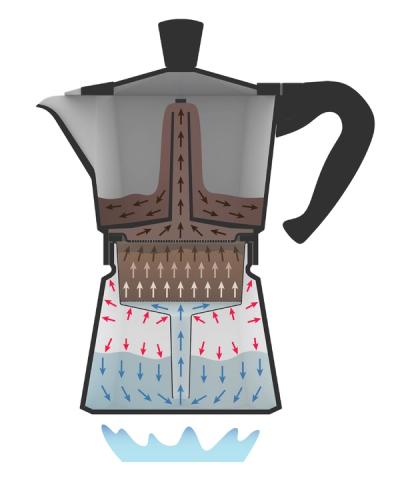How does a moka work?
Understanding how a moka pot works will help you fine-tune the taste of your coffee — and fix issues with burnt-tasting or watery coffee.
Moka pots are cleverly designed to create enough pressure to brew a coffee similar to espresso — and they do this using a few simple components.

A moka pot is made up of six main parts:
- Top Chamber: Collects the final brew and features a handle and spout for pouring.
- Filter Plate: Blocks coffee grounds from entering the finished drink.
- Gasket: Seals the gap between the filter plate and the top chamber.
- Funnel / Basket: Houses the coffee grounds.
- Bottom Chamber: Holds water and contains the safety valve.
- Safety valve: Prevents the moka pot from exploding.
Assembly
The bottom chamber is filled with water. The funnel, filled with coffee grounds, is slotted into the bottom chamber so that its base is submerged in the water. The top chamber, which has the gasket and filter plate attached, is screwed onto the bottom chamber.
Once the moka pot is assembled and placed on a stovetop, the brewing process can begin.

How a moka pot works
As heat is applied to the water in the bottom chamber, some of it turns to steam, filling the air inside the chamber.
As the water temperature rises, steam occupies more of the remaining space, and pressure begins to build.

With no outlet for the steam, it compresses the water, which is then forced — against gravity — up the spout at the funnel's bottom, through the coffee grounds, and up the spout in the center of the top chamber.

As the water passes through the coffee, it absorbs the flavour, aroma, and color that constitute the final drink.
It's important to note that the water does not need to be boiling for the moka pot to work. Water vapour from very hot (but not boiling) water, can generate sufficient pressure to push the water through the coffee.1
Why create high pressure?
High pressure is crucial in this process for a couple of reasons.
Firstly, finer grounds are necessary for espresso-like drinks — but they require higher pressures to prevent clogging.
Imagine pouring water onto a tightly packed puck of finely ground coffee— the water would simply sit on top of it. Pressure is required the force the water through the grounds.
Secondly, higher water pressure is more efficient at extracting carbon dioxide from coffee grounds — essential for forming crema.
What effects the pressure?
The pressure required to force the water up the funnel and through the coffee depends on many things — but it comes down to four main variables:
- Gravity: The force of gravity pulling down on the water. Unlikely to change unless you're making coffee off planet.
- Air pressure: The force of the weight of air molecules in the atmosphere that the water has to overcome.
- Filtration Pressure: the force required for the water to pass through the coffee grounds — this is mostly dependent on grind size.2
- Water temperature: The higher the temperature of the water, the more pressure from steam is generated.
The amount of increased pressure required for the moka pot to work is less than you might thing — one study showed it to be an average of 3.2 kPa — just one 1/30 of normal atmospheric pressure.3
What's the safety valve for?
The safety valve is a mechanism that allows steam to escape once a set pressure is reached — averting any risk of for an explosive accident.
If the grounds are too fine or have been packed too tightly, they can create a barrier that increases the required pressure, sometimes to a dangerous level. Under these circumstances the safety valve will release steam.
It's critical to never to fill the water in the lower-chamber above the safety valve — doing so will prevent the safety valve from working!
Understanding how a moka pot works helps You fine-tune your coffee
Understanding the forces at play in your moka pot can help you fine-tune how you make your coffee.
Using Finer Grounds
Regardless of your brew method — whether you use a french press, an espresso machine, or a moka pot — a finer grind size results in a more intense, stronger coffee. The grounds have a higher surface area for flavours to dissolve into water.
In a moka pot, the effect of using a finer grind size is more pronounced. Finer grounds also make it harder for the water to pass through, increasing the water pressure, resulting in more carbon dioxide being dissolved into your coffee. This creates more crema and a richer drink.
Remember—grounds that are too fine will block the passage of water too much. This can cause the funnel and upper chamber of the moka pot to excessively heat, burning your coffee grounds. The resulting coffee will taste disgusting, or possibly never brew at all.
Using coarser grounds
Having an overly coarse grind size is less problematic — you may find that the lower pressure results in an under-extracted, watery brew.
Tamping the Coffee
Tamping—compressing the coffee in the filter as you would for an espresso shot—will also increase the water pressure yielding a stronger coffee. We don't recommend you do this, as it increases the chance of clogging and over-extraction.
Where to learn more
We've covered the basics of how a moka pot works — but you might be interested in learn more about the physics going on inside. If so check out our citations below.